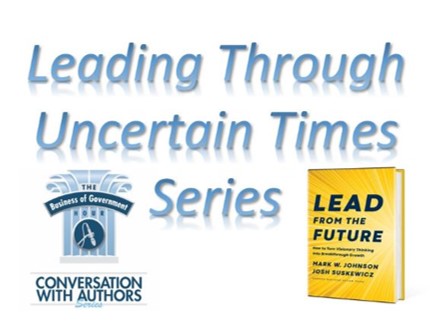
Lead From The Future: Interview with Mark W. Johnson

I have dedicated a series of shows exploring the qualities, tools, tactics, and mindset leaders from all sectors may need to navigate unsettling times and transform order out of chaos. The authors and thinkers presented in this series offer insights and advice applicable to all sectors, especially the public sector.
What is future-back thinking? How can it help leaders navigate today’s disruptions (i.e., COVID-19 and its response), and lead with purpose? Mark W. Johnson, co-author with Josh Suskewicz of Lead from the Future: How to Turn Visionary Thinking into Breakthrough Growth joined me on The Business of Government Hour to discuss these questions and more. Here’s a sampling of insights from our conversation that can perhaps today’s government executives meet their mission in an every changing world.
From Vision to Strategy
An inspiring and galvanizing vision is only the “what,” not the “how.” Vision is made actionable through strategy, which is the means to achieve it. Simply put, strategy is a way to win a game. Vision tells you what game you will play. The two go together, as vision without strategy is inspiration without a real way to get to action. Vision defines the ends/ the destination while strategy defines the means and the journey to get there. Developing and deploying an inspiring and actionable vision is a skill that can be learned. Beyond that, it can be driven into the cultures of even the most hidebound organizations, reigniting their entrepreneurial fires and infusing them with a renewed sense of purpose and direction.
Tyranny of the Present
In a world that is shifting so rapidly that the next ten years could witness as much change as the last century, the potential for disruption is high. Meanwhile, a troubling trend is emerging. We conducted a survey of executives across a wide variety of industries around the world. Fully 75 percent reported that their planning and forecasting horizons are never more than five years out. Only 10 percent plan for eight to ten years or more.
If you are only thinking two or three years ahead, years five to ten might bring you an unwelcomed surprise, unanticipated challenge, or even worse missed opportunities. Most leaders understand this—but the pull of the present, I often reference a Harvard Business Review article by Michael Porter and Nitin Nohria in 2018 stating the average CEO is in thirty-seven meetings per week that takes up 72 percent of their time, prevents them from really engaging with the future. This is where future-back thinking and strategy can help.
Present-Forward versus Future-Back Thinking
Future-back thinking is low in initial knowledge and high in assumptions—its aim is to discover what could be true. It has similarities with design thinking. Though future-back thinking cannot predict the future, it can recognize patterns and trends and build on them, fleshing them out with informed imagination to create a plausible picture of how the future might be shaped. Future-back thinkers employ problem-solving methods that are less structured, as they deal with a combination of what is known, what is unknown, and what is imagined or envisioned. Our future-back approach is relatively simple: setting aside your assumptions about the way things work today, think carefully about your destination—your organization’s target end state in the future and then develop and implement a step-by-step plan to get there. Future-back thinking focuses on exploration by identifying what assumptions can be made about the future; it works at envisioning what an enterprise future state could look like, and then discovery through experimenting about the future today.
For example, future-back inspired thinking and innovation can create new markets that require new business models. It also has value in how organizations respond to the COVID-19 crisis. Future-back thinking can help leaders transform their core business models in order to weather pretty serious economic downturns. It is about reinventing the core elements of a business and organization and reposition it to ensure it stays sustainable for the long-term.
Traditional strategic planning is data-driven and analytic. It tends to use an organization’s present circumstances as a base or template and then extends it into the future. In contrast, future-back vision and strategy derives from a process of active learning via structured dialogues, as leaders work together in a much more participative way to build a shared understanding of a very different future and align on it. It is more organic; participants focus on the questions as much as the answers, on assumptions as much as facts.
A Tribute to a Visionary Leader
We like to use the analogy of Wayne Gretzky, the famous hockey player. It’s about skating not just to where the puck is going but being able to shape where the puck should go. To me, that is a visionary leader: a person with a clear-eyed view of the future, an understanding of how they fit into that future, and a plan that inspires others to be part of that journey.
Our book is a tribute to Clay Christensen as visionary leader. He embodies what it means to lead from the future. His seminal theory of disruption stems from a fundamental understanding: that when leaders develop and use good theory, their efforts in strategy and innovation can become much more predictable. I think of the theory that undergirds Lead from the Future in much the same way. Leaders can use it to put themselves in an envisioned future, frame its circumstances as a “situation I’m in,” and then develop clear-eyed views about the most effective ways to innovate within it. We want leaders from all sectors to embrace the value of a longer-term planning horizon and to be more forward-looking.





